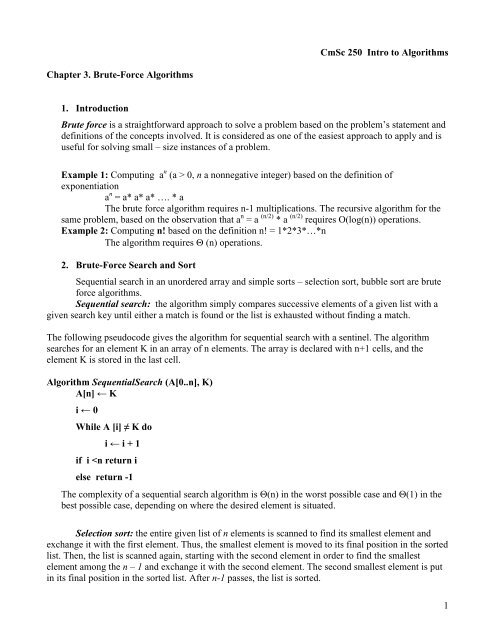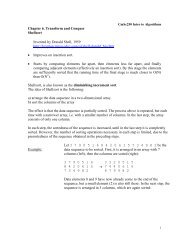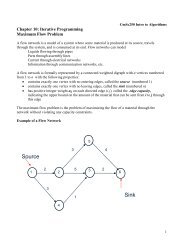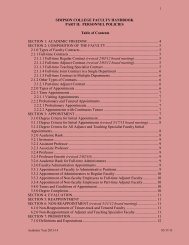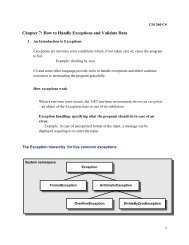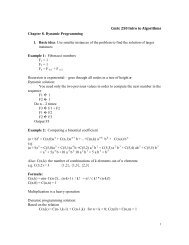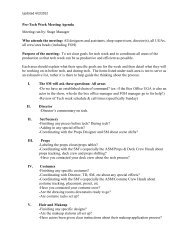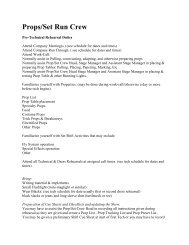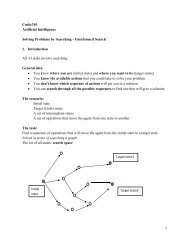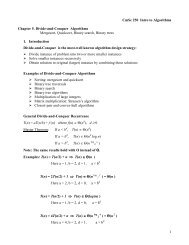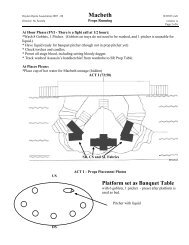Brute Force
Brute Force
Brute Force
Create successful ePaper yourself
Turn your PDF publications into a flip-book with our unique Google optimized e-Paper software.
CmSc 250 Intro to AlgorithmsChapter 3. <strong>Brute</strong>-<strong>Force</strong> Algorithms1. Introduction<strong>Brute</strong> force is a straightforward approach to solve a problem based on the problem’s statement anddefinitions of the concepts involved. It is considered as one of the easiest approach to apply and isuseful for solving small – size instances of a problem.Example 1: Computing a n (a > 0, n a nonnegative integer) based on the definition ofexponentiationa n = a* a* a* …. * aThe brute force algorithm requires n-1 multiplications. The recursive algorithm for thesame problem, based on the observation that a n = a (n/2) * a (n/2) requires O(log(n)) operations.Example 2: Computing n! based on the definition n! = 1*2*3*…*nThe algorithm requires (n) operations.2. <strong>Brute</strong>-<strong>Force</strong> Search and SortSequential search in an unordered array and simple sorts – selection sort, bubble sort are bruteforce algorithms.Sequential search: the algorithm simply compares successive elements of a given list with agiven search key until either a match is found or the list is exhausted without finding a match.The following pseudocode gives the algorithm for sequential search with a sentinel. The algorithmsearches for an element K in an array of n elements. The array is declared with n+1 cells, and theelement K is stored in the last cell.Algorithm SequentialSearch (A[0..n], K)A[n] ← Ki ← 0While A [i] ≠ K doi ← i + 1if i
Algorithm SelectionSort (A[0..n-1])for i ← 0 to n-2 domin ← ifor j ← i + 1 to n-1 doif A[j] < A[min]swap A[i] and A[min]min ← jThe basic operation of the selection sort is the comparison - A[j] < A[min]. The complexity of thealgorithm is (n 2 ) and the number of key swaps is (n).Bubble sort is another application of a brute force. In the algorithm, adjacent elements of the list arecompared and are exchanged if they are out of order.Algorithm BubbleSort (A[0..n-1])for i ← 0 to n-2 dofor j ← 0 to n – 2 – i doif A[j+1] < A[j]swap A[j] and A[j+1]The basic operation of the bubble sort is comparison - A[j+1] < A[j] and swapping - swap A[j] andA[j+1]. The number of key comparisons is the same for all arrays of size n and it is (n 2 ). However,the number of key swaps depends on the input and in the worst case is (n 2 ). The aboveimplementation of Bubble sort can be slightly improved if we stop the execution of the algorithm whena pass through the list makes no exchanges (i.e. indicating that the list has been sorted). Thus, in thebest case the complexity will be (n) and the worst case (n 2 ).3. <strong>Brute</strong>-<strong>Force</strong> String MatchingA brute force algorithm for string matching problem has two inputs to be considered: pattern (a stringof m characters to search for), and text (a long string of n characters to search in). Algorithm starts withaligning a pattern at the beginning of text. Then each character of a pattern is compared to thecorresponding character, moving from left to right, until all characters are found to match, or amismatch is detected. While the pattern is not found and the text is not yet exhausted, a pattern isrealigned to one position to the right and again compared to the corresponding character, moving fromleft to right.Pattern: happyText: It is never too late to have a happy childhood.happyhappy…happy2
The number of comparisons done for this problem is (nm) in the worst possible case and (n+m) (n) in the average case.4. Closest Pair and Convex Hull problemsThe closest-pair problem is to find the two closest points in a set of n points in k-dimensionalspace. We consider a 2 dimensional case of the problem for simplicity. A brute force implementationof this problem computes the distance between each pair of distinct points and finds the pair with thesmallest distance.Algorithm ClosestPairPoints (P)dmin ← ∞for i ← 1 to n-1 dofor j ← i + 1 to n dod ← sqrt ((x i – x j ) 2 + (y i – y j ) 2 )if d < dmindmin ← dThe basic operation of the algorithm is computing the Euclidean distance between two points:d ← sqrt ((x i – x j ) 2 + (y i – y j ) 2 ).An improved algorithm would be if we just compare the values (x i – x j ) 2 + (y i – y j ) 2 instead of takingthe square root. The basic operation is dsqr ← (x i – x j ) 2 + (y i – y j ) 2 .The complexity for the algorithm is (n 2 ).The Convex-hull problem tries to find the smallest convex polygon enclosing n points on the plane(i.e. find the points that will serve as vertexes to the polygon). There are some definitions that need tobe made for this problem:1. Convex set: For any two points P and Q in the set, the entire line segment with the endpoints at P and Q belongs to the set2. Convex hull of a set S of points is the smallest convex set containing SThe convex hull of any set S of n > 2 points is a convex polygon with vertexes at some points of S.<strong>Brute</strong> force algorithm: for each pair of points p1 and p2, determine whether all other points lieto the same side of a straight line through p1 and p2. If so, the line segment connecting p1 and p2 is apart of the convex hull’s boundary.3
Algorithm:for each pair (p1, p2) of n(n-1)/2 pairs of distinct pointsDetermine the line incident with p1 and p2, i.e. determine the coefficients a, b,and c of the equation ax + by – c = 0 such that the coordinates of p1 and p2 are roots of theequation.the convex hull.for each of the other n – 2 pointsfind the sign of ax + by – c.If the sign is the same for all n-2 points, then p1 and p2 are vertexes inThe time efficiency of this algorithm is O(n 3 ).5. Exhaustive SearchExhaustive search is used in problems where the solution is an object with specific properties in aset of candidate solutions. We have to examine all candidate solutions to find the solution if itexists. There are two types of problems that involve exhaustive search – state-space searchproblems and combinatorial problems.5.1. State-space searchIn state-space search the problem is formulated as follows: Given an initial state, a goal state,and a set of operations, find a sequence of operations that transforms the initial state to the goalstate. The solution process can be represented as a tree with the initial state being its root, andthe goal state being a leaf in the tree, and each edge corresponds to an operation.At each node we attempt to apply all available operations. When an operation is applied, a newnode is generated. If no operation can be applied, the node is called “dead end”. The processterminates when a node is generated that satisfies the requirements of the goal state or when nomore nodes can be generated.The search can be performed in a breadth-first manner or in a dept-first manner. Theproblem-solving method is called “generate-and-test” approach because we generate a node andtest to see if it is the solution.Exhaustive search is not feasible if the search tree grows exponentially. If this is thecase, the generated nodes have to be evaluated (if possible) and so that at each step the bestnode is expanded.Many Artificial Intelligence problems fall into this category, e.g. the 8-puzzle problem.5.2. Combinatorial problemsIn combinatorial problems the solution (if is exists) is an element of a set of combinatorialobjects – permutations, combinations, or subsets. The brute-force approach consists ingenerating the combinatorial objects and testing each object to see if it satisfies some specifiedconstraints. Problems like the traveling salesman, knapsack, and bin-packing can be solved byusing an exhaustive search.4
The traveling salesman problem tries to find the shortest tour through a given set of n citiesthat visits each city exactly once before returning to the city whether it started. Since each touris a permutation of the n cities, and since we can fix the start city, the time efficiency of thisalgorithm is ((n-1)!).The knapsack problem, for given n items with their benefits and volume, tries to find themost valuable subset (i.e. the one with the greatest benefit) without exceeding the capacity ofthe knapsack. The solution is one of all subsets of the set of objects and therefore the timeefficiency of this algorithm is (2 n ).In the assignment problem we have n persons that have to be assigned n jobs, one personper job. The problem is represented as a cost matrix, where c(i,j) is the cost of assigning job jto person i. The solution is a vector (a 1 , a 2 , ..a n ) such that person i is assigned job a i and the sumc(i,a i ) is minimum. The solution is a permutation of the n jobs and therefore the time efficiencyis (n!).Exhaustive search algorithms run in a realistic amount of time only on very small instancesof the problem at hand. In many cases, there are much better alternative algorithms. Forexample the 8-puzzle problem is solved using the heuristic A* algorithm. However, in somecases such as the traveling salesman problem, exhaustive search is the only known algorithm toobtain exact solution. Approximate algorithms are used to solve realistic instances of suchproblems.6. Conclusion .The strengths of using a brute force approach are as follows: It has wide applicability and is known for its simplicity. It yields reasonable algorithms for some important problems such as searching,string matching, and matrix multiplication. It yields standard algorithms for simple computational tasks such as sum andproduct of n numbers, and finding maximum or minimum in a list.The weaknesses of the brute force approach are as follows: It rarely yields efficient algorithms. Some brute force algorithms are unacceptably slow. It is neither as constructive nor creative as some other design techniques.5


